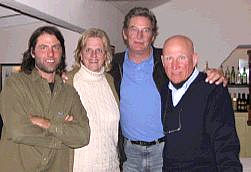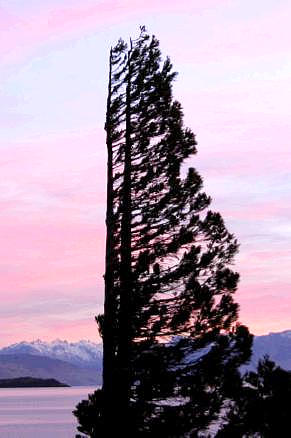
In Patagonia I sat in the beauty of nothing and photographed light. Also photographing and staying at the same coastal estancia as I on Argentina’s Peninsula Valdez was renowned documentary photographer Sebastiao Salgado. He is working on a 10-year “Genesis” project for UNESCO, creating photographs of the natural world undisturbed by humans. Sundowner chats and dinner conversations with him centered on the criteria by which one is deemed an artist, the influence of digital technology on photography, the effect of humans on the environment and the future of the planet. No trivial pursuits!
Back in NYC, I found in my “New Yorker Magazine” (April 18, 2005) a major profile of his work as a singular documentation of what, for better or worse, is our singular moment in history. In June I was with Sebastiao and his wife Lélia at the National Arts Club as he received the Gold Medal of Photography for his searing yet compassionate black-and-white images displayed on the walls that night. He depicts the struggles man imposes on man, the ravages man has wrought on nature and vice versa.

Mesmerized by the luminosity and lyricism that defines Sebastiao’s photographic style, I read Susan Sontag’s Regarding the Pain of Others which critiques Salgado’s imagery of pain, poverty and cruelty. While her insights and historic and literary references broadened my perspectives, I disagree with her theory on “the inauthenticity of the beautiful” and her claim that images of “world misery” must be crudely styled out of respect for the subject. I dispute her opinion that “a beautiful photograph drains attention from the sobering subject and turns it toward the medium itself, thereby compromising the picture’s status as a document.” (Sontag, p. 77)
Sebastiao is an artist whose images go inside reality to hold the viewer’s eye and haunt their thoughts. The grainy, edgy images of many photojournalists whom Sontag extolls usually produce such repulsed reactions that viewers instantly try to forget what they’ve just seen. Sebastiao’s images seem to me to have longer-lasting and deeper power. In Salgado’s photographs, a strong artistic form serves strong, desperate content.
Three weeks after Argentina, I visited Croatia. Visiting Dubrovnik and its Museum of War Photography, I continued to delve into this issue. I spent an hour in this newly dedicated museum viewing images by photographers, with press deadlines to meet, of breaking news – usually ghastly, gory moments. These are important images of what has just happened and necessary wake-up calls to the world – even though nothing can undo the action in the image.
Salgado’s art plays a different role – he documents ongoing conditions that can be corrected. His work is self-assigned on a self-determined schedule. He has time to connect in kinship with his subjects and the meaning and pace of their lives. His exquisitely wrought compositions smolder with content that brings a viewer’s attention to what happens before and after the news photographers’ “decisive moments.” Whether photographing grand or intimate scenes, Salgado does so with a palpably deep respect for the dignity of the individual’s struggle. This allows the viewer of his images, even though being exposed to upsetting content, to ponder why… how… and then, possibly some solutions to the world’s struggles. Salgado’s camera captures the tangles in the social web of humankind.
BIBLIOGRAPHY
Published Sebastiao Salgado:
An Uncertain Grace. Aperture, 1990. On the world’s often-ignored people.
Workers: Archeology of the Industrial Age. NY: Aperture, 1993. On vanishing forms of manual labor and disappearance of the traditional working class.
Terra: Struggle of the Landless. NY: Aperture, 1998. On land struggle in Brazil, 1980–1996.
Migrations: Humanity in Transition. NY: Aperture, 2000. On “the reorganization of the human family,” as hundreds of millions of people in Africa, Asia and Latin America have left homes en masse for political or economic reasons.
Related books:
Cornell Capa. The Concerned Photographer. Grossman Publishers, 1968. An early influence for Salgado.
Sontag, Susan. Regarding the Pain of Others. New York, 2003.
Woolfe, Virginia, Three Guineas. Harcourt Brace & Co., 1938. This essay is her answer to 3 separate requests for a guinea donation toward education, women’s employment and halting war. She concludes they are inseparably the same. (Recommended by Sontag.)